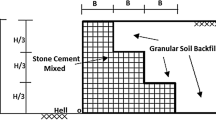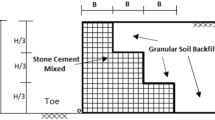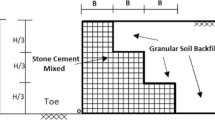Abstract
Due to the fact that uncertainties in the field of geotechnical engineering are inescapable because this part of civil engineering deals largely with natural materials, the dependability analysis of geotechnical structures has gotten a lot of attention in recent decades. This study looks at the reliability of embedded depth of cantilever sheet pile walls that are embedded in cohesive soil and backfilled with cohesionless soil. For the reliability analysis, the first-order reliability method (FORM) was employed to analyse the cantilever sheet pile. With the use of various optimization strategies, namely artificial bee colony, ant colony optimization, ant lion colony, imperialist competitive algorithm, shuffled complex evolution and teaching–learning-based optimization, the widely used artificial neural network (ANN) is used to forecast the embedment depth of a cantilever sheet pile wall. The input variables for predicting pile embedded depth include soil properties such as cohesiveness (c), angle of internal friction (φ) and unit weight (γ). To assess the models` performance, the reliability index, rank analysis, Taylor diagram, accuracy matrix, DDR criterion, AIC criterion, and OBJ criterion are utilised. Based on the experimental results, the hybrid models of ANN and teaching–learning-based optimization (ANN-TLO) perform better in predicting the reliability of cantilever sheet pile walls. The proposed approach can be utilised to quantify the risk associated with such structures in civil engineering projects as an alternative tool.











Similar content being viewed by others
Availability of data and material
Data and material are available upon reasonable request.
Code availability
Code is available upon reasonable request.
References
GuhaRay, A.; Baidya, D.K.: Reliability-based analysis of cantilever sheet pile walls backfilled with different soil types using the finite-element approach. Int. J. Geomech. 15(6), 06015001 (2015). https://doi.org/10.1061/(asce)gm.1943-5622.0000475
INTERNATIONAL STANDARD ISO structures. (2015).
King, G.J.: Analysis of cantilever sheet-pile walls in cohesionless soil. J. Geotech. Eng. 121(9), 629–635 (2015). https://doi.org/10.1061/(ASCE)0733-9410(1995)121:9(629)
Singh, A.P.; Chatterjee, K.: Influence of soil type on static response of cantilever sheet pile walls under surcharge loading: a numerical study. Arab. J. Geosci. (2020). https://doi.org/10.1007/s12517-020-5170-x
Georgiadis, M.; Anagnostopoulos, C.: Effect of berms on sheet-pile wall behaviour. Geotechnique 48(4), 569–574 (1998). https://doi.org/10.1680/geot.1998.48.4.569
Gajan, S.: Normalized relationships for depth of embedment of sheet pile walls and soldier pile walls in cohesionless soils. Soils Found. 51(3), 559–564 (2011). https://doi.org/10.3208/sandf.51.559
Viswanadham, B.V.S.; Madabhushi, S.P.G.; Babu, K.V.; Chandrasekaran, V.S.: Modelling the failure of a cantilever sheet pile wall. Int. J. Geotech. Eng. 3(2), 215–231 (2009). https://doi.org/10.3328/IJGE.2009.03.02.215-231
Nataraj, M.S.; Hoadley, P.G.: Design of anchored bulkheads in sands. J. Geotech. Eng. 110(4), 505–515 (1984). https://doi.org/10.1061/(ASCE)0733-9410(1984)110:4(505)
Madabhushi, G.S.P.; Chandrasekaran, V.S.: Rotation of cantilever sheet Pile walls. J. Geotech. Geoenviron. Eng. 131(2), 202–212 (2005). https://doi.org/10.1061/(asce)1090-0241(2005)131:2(202)
Shqip, A. S., Spitaleve, A. S. E., Forum, I., Anti-pole, T. H. E., Utopias, B., Fiction, S., Sheet, C., Wall, P., Clay, P., Reuse, T. H. E., Industrial, O. F., As, H., Approach, A. N., & Restorative, T. O.: Artikuj shkencore shqip kujtesa si hapësirë heterotopike (2017)..
Day, R.A.: Net pressure analysis of cantilever sheet pile walls. Géotechnique 51(2), 185–187 (2001). https://doi.org/10.1680/geot.51.2.185.40282
Babu, G.L.S.; Basha, B.M.: Optimum design of cantilever sheet pile walls in sandy soils using inverse reliability approach. Comput. Geotech. 35(2), 134–143 (2008). https://doi.org/10.1016/j.compgeo.2007.04.001
Kawa, M.; Pula, W.; Suska, M.: Random analysis of bearing capacity of square footing using the LAS procedure. Studia Geotechnica et Mechanica (2016). https://doi.org/10.1515/sgem-2016-0021
Basma, A.A.: Reliability-based design of sheet pile structures. Reliab. Eng. Syst. Saf. 33(2), 215–230 (1990)
Prästings, A.; Larsson, S.; Müller, R.: Transportation Geotechnics Multivariate approach in reliability-based design of a sheet pile wall. Transp Geotech 7, 1–12 (2016). https://doi.org/10.1016/j.trgeo.2016.03.001
Nazari, A., Rajeev, P., & Sanjayan, J. G.: Offshore pipeline performance evaluation by different artificial neural networks approaches. Measur. J. Int. Measur. Confeder., 76, 117–128 (2015). https://doi.org/10.1016/j.measurement.2015.08.035
Kardani, N.; Bardhan, A.; Gupta, S.; Samui, P.; Nazem, M.; Zhang, Y.; Zhou, A.: Predicting permeability of tight carbonates using a hybrid machine learning approach of modified equilibrium optimizer and extreme learning machine. Acta Geotech. (2021). https://doi.org/10.1007/s11440-021-01257-y
Asteris, P.G.; Mamou, A.; Hajihassani, M.; Hasanipanah, M.; Koopialipoor, M.; Le, T.T.; Kardani, N.; Armaghani, D.J.: Soft computing based closed form equations correlating L and N-type Schmidt hammer rebound numbers of rocks. Transp. Geotech. 29, 100588 (2021). https://doi.org/10.1016/j.trgeo.2021.100588
Kardani, N.; Zhou, A.; Shen, S.L.; Nazem, M.: Estimating unconfined compressive strength of unsaturated cemented soils using alternative evolutionary approaches. Transp. Geotech. 29, 100591 (2021). https://doi.org/10.1016/j.trgeo.2021.100591
Raja, M.N.A.; Shukla, S.K.: Predicting the settlement of geosynthetic-reinforced soil foundations using evolutionary artificial intelligence technique. Geotext. Geomembranes 49(5), 1280–1293 (2021)
Raja, M.N.A.; Shukla, S.K.; Khan, M.U.A.: An intelligent approach for predicting the strength of geosynthetic-reinforced subgrade soil. Int. J. Pavement Eng. (2021). https://doi.org/10.1080/10298436.2021.1904237
Chang, C. M., Lin, T. K., & Chang, C. W (2018) Applications of neural network models for structural health monitoring based on derived modal properties. Measur.: J. Int. Measure. Confederat. 129: 457–470 https://doi.org/10.1016/j.measurement.2018.07.051
Bhawan, A., Delhi, N., Gwalior, M., Road, M. L., & Pradesh, M.: Artificial bee colony algorithm : a survey Jagdish Chand Bansal Harish Sharma * and Shimpi Singh Jadon. 5, 123–159 (2013).
Basu, M.: Artificial bee colony optimization for multi-area economic dispatch. Int. J. Electr. Power Energy Syst. 49(1), 181–187 (2013). https://doi.org/10.1016/j.ijepes.2013.01.004
Maeda, M.; Tsuda, S.: Reduction of artificial bee colony algorithm for global optimization. Neurocomputing 148, 70–74 (2015). https://doi.org/10.1016/j.neucom.2012.06.066
Shi, J.; Li, X.; Khan, F.; Chang, Y.; Zhu, Y.; Chen, G.: Artificial bee colony based bayesian regularization artificial neural network approach to model transient flammable cloud dispersion in congested area. Process Saf. Environ. Prot. 128, 121–127 (2019). https://doi.org/10.1016/j.psep.2019.05.046
Gheysari, K.; Khoei, A.; Mashoufi, B.: High speed ant colony optimization CMOS chip. Expert Syst. Appl. 38(4), 3632–3639 (2011). https://doi.org/10.1016/j.eswa.2010.09.017
Bououden, S.; Chadli, M.; Karimi, H.R.: An ant colony optimization-based fuzzy predictive control approach for nonlinear processes. Inf. Sci. 299, 143–158 (2015). https://doi.org/10.1016/j.ins.2014.11.050
Nguyen, D.C.H.; Ascough, J.C.; Maier, H.R.; Dandy, G.C.; Andales, A.A.: Optimization of irrigation scheduling using ant colony algorithms and an advanced cropping system model. Environ. Model. Softw. 97, 32–45 (2017). https://doi.org/10.1016/j.envsoft.2017.07.002
Mirjalili, S.: The ant lion optimizer. Adv. Eng. Softw. 83, 80–98 (2015). https://doi.org/10.1016/j.advengsoft.2015.01.010
Dubey, H.M.; Pandit, M.; Panigrahi, B.K.: Ant lion optimization for short-term wind integrated hydrothermal power generation scheduling. Int. J. Electr. Power Energy Syst. 83, 158–174 (2016). https://doi.org/10.1016/j.ijepes.2016.03.057
Rajan, A., Jeevan, K., & Malakar, T.: Weighted elitism based Ant Lion Optimizer to solve optimum VAr planning problem. In Applied Soft Computing Journal, Elsevier B.V., 55 (2017). https://doi.org/10.1016/j.asoc.2017.02.010
Kanimozhi, G.; Kumar, H.: Modeling of solar cell under different conditions by ant lion optimizer with LambertW function. Appl. Soft Comput. J. 71, 141–151 (2018). https://doi.org/10.1016/j.asoc.2018.06.025
Pradhan, R.; Majhi, S.K.; Pradhan, J.K.; Pati, B.B.: Optimal fractional order PID controller design using ant lion optimizer. Ain Shams Eng. J. 11(2), 281–291 (2020). https://doi.org/10.1016/j.asej.2019.10.005
Lucas, C.; Nasiri-Gheidari, Z.; Tootoonchian, F.: Application of an imperialist competitive algorithm to the design of a linear induction motor. Energy Convers. Manage. 51(7), 1407–1411 (2010). https://doi.org/10.1016/j.enconman.2010.01.014
Enayatifar, R.; Abdullah, A.H.; Lee, M.: A weighted discrete imperialist competitive algorithm (WDICA) combined with chaotic map for image encryption. Opt. Lasers Eng. 51(9), 1066–1077 (2013). https://doi.org/10.1016/j.optlaseng.2013.03.010
Bek, R. U., & Kosolapov, G. V.: The anodic dissolution of gold in alkaline cyanide solutions. Influence of impurities in solution on rate of process at low overpotentials. Izv. Sibir. Otd. Akad. Nauk SSSR, Khim, 2(3), 28–31 (1986).
Muttil, N.; Liong, S.Y.: Superior exploration-exploitation balance in shuffled complex evolution. J. Hydraul. Eng. 130(12), 1202–1205 (2004). https://doi.org/10.1061/(asce)0733-9429(2004)130:12(1202)
Zhao, F.; Zhang, J.; Wang, J.; Zhang, C.: A shuffled complex evolution algorithm with opposition-based learning for a permutation flow shop scheduling problem. Int. J. Comput. Integr. Manuf. 28(11), 1220–1235 (2015). https://doi.org/10.1080/0951192X.2014.961965
Rao, R.V.; Savsani, V.J.; Vakharia, D.P.: Teaching-learning-based optimization: an optimization method for continuous non-linear large scale problems. Inf. Sci. 183(1), 1–15 (2012). https://doi.org/10.1016/j.ins.2011.08.006
Sleesongsom, S.; Bureerat, S.: Four-bar linkage path generation through self-adaptive population size teaching-learning based optimization. Knowl.-Based Syst. 135, 180–191 (2017). https://doi.org/10.1016/j.knosys.2017.08.012
Vitayasak, S.; Pongcharoen, P.: Performance improvement of teaching-learning-based optimisation for robust machine layout design. Expert Syst. Appl. 98, 129–152 (2018). https://doi.org/10.1016/j.eswa.2018.01.005
Zou, F.; Chen, D.; Xu, Q.: A survey of teaching–learning-based optimization. Neurocomputing 335, 366–383 (2019). https://doi.org/10.1016/j.neucom.2018.06.076
Ct, A.B.: Reliability-based design of sheet pile structures. Reliab. Eng. Syst. Saf 33, 215–230 (1991)
Acharya, G.; Cochrane, T.A.; Davies, T.; Bowman, E.: The influence of shallow landslides on sediment supply: a flume-based investigation using sandy soil. Eng. Geol. 109, 161–169 (2009). https://doi.org/10.1016/j.enggeo.2009.06.008
Benson, B.C.H.; Member, A.; Zhai, H.; Wang, X.: Estimating hydraulic conductivity of compacted clay liners. J. Geotech. Engrg. 120, 366–387 (1994)
Ni, P.; Li, J.; Hao, H.; Yan, W.; Du, X.; Zhou, H.: Reliability analysis and design optimization of nonlinear structures. Reliab. Eng. Syst. Saf. 198, 106860 (2020). https://doi.org/10.1016/j.ress.2020.106860
Hasofer, A.M.; Lind, N.C.: An exact and invariant first order reliability format". J .Eng. Mech. Div. 100(EM1), 111–121 (1974)
Karaboga, D., & Basturk, B.: Artificial Bee Colony (ABC) optimization algorithm for solving constrained optimization problems. Lecture Notes in Computer Science (Including Subseries Lecture Notes in Artificial Intelligence and Lecture Notes in Bioinformatics), 4529 LNAI (December), 789–798 (2007). https://doi.org/10.1007/978-3-540-72950-1_77.
Blum, C.; López-Ibáñez, M.: Ant colony optimization. Intell. Syst. (2016). https://doi.org/10.4249/scholarpedia.1461
Khanna, K.; Rajpal, N.: Reconstruction of curves from point clouds using fuzzy logic and ant colony optimization. Neurocomputing 161, 72–80 (2015). https://doi.org/10.1016/j.neucom.2014.11.071
Hosseini, S.; Al Khaled, A.: A survey on the Imperialist Competitive Algorithm metaheuristic: implementation in engineering domain and directions for future research. Appl. Soft Comput. 24, 1078–1094 (2014). https://doi.org/10.1016/j.asoc.2014.08.024
Duan, Q.Y.; Gupta, V.K.; Sorooshian, S.: Shuffled complex evolution approach for effective and efficient global minimization. J. Optim. Theory Appl. 76(3), 501–521 (1993). https://doi.org/10.1007/BF00939380
Rao, R.V.; Savsani, V.J.; Balic, J.: Teaching-learning-based optimization algorithm for unconstrained and constrained real-parameter optimization problems. Eng. Optim. 44(12), 1447–1462 (2012). https://doi.org/10.1080/0305215X.2011.652103
Ray, R.; Kumar, D.; Samui, P.; Roy, L.B.; Goh, A.T.C.; Zhang, W.: Application of soft computing techniques for shallow foundation reliability in geotechnical engineering. Geosci. Front. 12(1), 375–383 (2021)
Khan, M.U.A.; Shukla, S.K.; Amjad Raja, M.N.: Soil–conduit interaction: an artificial intelligence application for reinforced concrete and corrugated steel conduits. Neural. Comput. Appl. 33(10), 1–25 (2021). https://doi.org/10.1007/s00521-021-06125-0
Kaloop, M.R.; Bardhan, A.; Kardani, N.; Samui, P.; Hu, J.W.; Ramzy, A.: Novel application of adaptive swarm intelligence techniques coupled with adaptive network-based fuzzy inference system in predicting photovoltaic power. Renew. Sustain. Energy Rev. 148, (2021). https://doi.org/10.1016/j.rser.2021.111315
Kardani, N.; T, P.; Samui, P.; Kim, D.; Zhou, A.: Smart phase behavior modeling of asphaltene precipitation using advanced computational frameworks: ENN, GMDH, and MPMR. Pet. Sci. Technol. (2021). https://doi.org/10.1080/10916466.2021.1974882
Jalal, F.E.; Xu, Y.; Iqbal, M.; Jamhiri, B.; Javed F.M.: Predicting the compaction characteristics of expansive soils using two genetic programming-based algorithms. Transp. Geotech 30, 100608 (2021)
Iqbal, M.; Onyelowe, K.C.; Jalal, F.E.: Smart computing models of California bearing ratio, unconfined compressive strength, and resistance value of activated ash-modified soft clay soil with adaptive neuro-fuzzy inference system and ensemble random forest regression techniques. Multiscale Multi Model Exp Des (2021). https://doi.org/10.1080/10916466.2021.1974882
Iqbal, M.; Zhao, Q.; Zhang, D.; Jalal, F.E.; Jamal, A.: Evaluation of tensile strength degradation of GFRP rebars in harsh alkaline conditions using non-linear genetic-based models. Mater. Struct. 54(5), 1–20 (2021)
Noori, R.; Khakpour, A.; Omidvar, B.; Farokhnia, A.: Comparison of ANN and principal component analysis-multivariate linear regression models for predicting the river flow based on developed discrepancy ratio statistic. Expert Syst Appl 37, 5856–5858 (2010). https://doi.org/10.1016/j.eswa.2010.02.020
Gandomi, A.H.; Alavi, A.H.; Sahab, M.G.; Arjmandi, P.: Formulation of elastic modulus of concrete using linear genetic programming. J. Mech. Sci. Technol. 24(6), 1011–1017 (2010). https://doi.org/10.1007/s12206-010-0330-7
Golbraikh, A.; Tropsha, A.: Beware of q 2!. 20, 269–276 (2002).
Roy, P.P.; Roy, K.: On some aspects of variable selection for partial least squares regression models. QCS 3, 302–313 (2008). https://doi.org/10.1002/qsar.200710043
Funding
The authors confirm that this research work content has no conflict of interest.
Author information
Authors and Affiliations
Corresponding author
Ethics declarations
Conflict of interest
The authors confirm that this research work content has no conflict of interest.
Consent for publication
All authors give their consent for publication.
Rights and permissions
About this article
Cite this article
Pradeep, T., GuhaRay, A., Bardhan, A. et al. Reliability and Prediction of Embedment Depth of Sheet pile Walls Using Hybrid ANN with Optimization Techniques. Arab J Sci Eng 47, 12853–12871 (2022). https://doi.org/10.1007/s13369-022-06607-w
Received:
Accepted:
Published:
Issue Date:
DOI: https://doi.org/10.1007/s13369-022-06607-w




